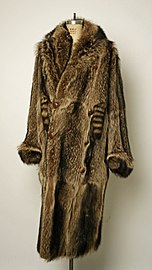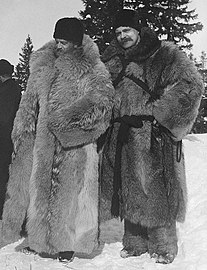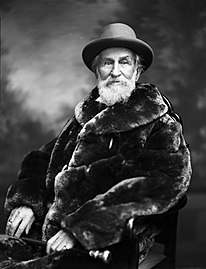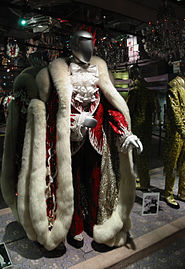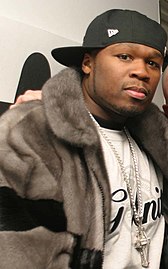Men's fur
With men's fur or men's fur, a fur coat or jacket for men is usually meant today, which is worn with the hair facing outwards. The term actually also includes fur-lined fabric outerwear for men, such as historical faux fur (city fur), chauffeur fur , travel fur and uniform fur , as well as the nude fur , mostly worn with the leather side facing outwards , the latter today known as velor or nappa fur.
General
Fashion has favored men's fur to varying degrees at different times. However, since the advent of fur fashion, in which fur is not only visible as a collar, cuff or other trim, but the outside shows the fur, men's furs have been less and less common than women's furs. What is already visible in the fact that the term “fur” is actually always thought of as a woman's fur, the term “woman's fur” is rarely used.
history
Fur wrappings are probably the first warming garments for men and women, as they were used in meat hunting for hairy animals. As one can deduce from the indigenous peoples, the men's fur was, in addition to its role as protection against the cold, always a status indicator, the slung predator's fur indicates the courageous and successful hunter. This type of distinction is continued in ancient cultures, the skin of the Nemean lion is the attribute of Heracles , and for centuries Chinese rulers sat on a throne covered with a tiger skin. In the male fur clothing one could read the status and dignity, or at least the wealth of the wearer. The rural population mainly wore sheepskin and goat skin , the simple urban population could possibly afford fur from native wild animals. The upper middle class of the Middle Ages dressed themselves excellently in a valuable marten-lined or lined with imported furs and occupied scarf , which was worn in summer and winter. For the nobility and the upper clergy, certain types of fur were temporarily reserved by dress code , this was especially true for the royal ermine .
Outer fur
When, in the extremely harsh winter of 1808/1809 in Paris, the first men's furs with the fur facing outwards appeared, their wearers were harassed on the street because of the unusual nature of these items of clothing.
Late 19th century to 1945
After Napoleon's unsuccessful winter campaign of 1814 , the outer fur was in fashion as a long coat for a short time, only to disappear inside as the fur lining of a travel coat. A real fashion fur for men did not appear until around 1900 with the use of the automobile, although it was actually only a continuation of the previous sleigh, carriage and travel fur. The motorist's furs were initially floor-length, later they were more often pallet-length . Particularly bulky, strong fur types were preferred, they were in the tradition of the so-called " game shearing ". The striking, powerful coats not only kept warm in the initially open and for a long time unheated vehicles, they also represented the proud owner of this new acquisition. The fur types most frequently used were sheepskins and raccoon skins , more rarely wolf skins and occasionally even the skins of big bears . From this a fashion developed by wealthy college students in the USA in the 1920s / 30s, especially as raccoon-coat-collegiate fashion. He was considered a status symbol; "The giant coat from 'raccoon', which had contained the message 'belonging to a famous college', had now entered general use in the 'severe winter version' of sporty outerwear". After him, a fashion epoch for long-haired men's furs came to an end for some time.
- Raccoon men's fur
Henri Fournier (France, 1898)
Metropolitan Museum of Art (1931)
The Italian fashion writer Anna Municchi said that after the appearance and the explosion of the fashion of the misshapen car jacket, which one would have to assume “that the driver dressed in this way was absolutely unacceptable for any other situation”, everything is now allowed in men's fur fashion was. In 1902 the last piece of news was a sport paletot made of sealskin , with short, shiny black hair, lined with fabric and trimmings made from Australian opossum , and, if desired, gaiters. An alternative was sporty fur, also recommended for hunters and alpinists, made of light or dark gray fabric and with lamb fur , bear or nutria . The first reversible coats appeared, mostly made of shorter-haired fur, so that the fur could also be worn more inconspicuously outside the car.
The famous American department store Sears had been selling coats made from Galloway cattle skins since the beginning of the 20th century . An essential feature of the Galloways is their double-layered coat with long, wavy outer hair and fine, dense undercoat. They were double-breasted coats made of beef or calfskin with large, warm shoulder collars that were widely worn in the United States from the 1920s to 1930s. In 1931, Sears was selling Galloway pelts for just over double a traditional Chesterfield . They had long-haired fur, were tanned with tree bark and "don't stink even when they get wet".
Whaler William Penny in a Seal Skin Shirt (1853)
Reindeer Skin Coat (Russia, 1886)
Frontiersman NK Boswell (1919)
Antarctic aviator Carl Ben Eielson (1929)
After 1945
After the Second World War, the raccoon fur coat was common for both sexes. General Mac Arthur , Commander of the 42nd American Division, wore it, double-breasted with large buttons, in one of his most famous photos. In the meantime, the nappa and velor lambskins to be worn with the hair inside, sometimes worked as a turner, were in common use. From the winter clothing used by the military until the end of 1930, the shearling , the fur made from the skins of sheep that had already been shorn, now developed in very different regions . In England it was offered with all the special features of a simply cut, single-breasted tweed jacket. In Northern Europe it was a little longer and often had a quilted yoke. In America it was a knee-length double-breasted suit.
At the beginning of the 1950s, the men's outer fur was largely forgotten. 1957 began the first major attempts to reintroduce it into fashion. The respected Parisian furrier André Sauzaie wore an oposs coat for advertising purposes . From the end of the 1960s, leading fashion designers added outer fur to their collections in addition to the previous men's fur linings and fur trimmings. In 1969, the men's outfitter Brioni showed a knee-length, eye-catching double-breasted pair of nutria with a leopard-printed foal skin . The men's furs by Gaetano Savini , the co-founder of Brioni, were much more discreet ; in the same year he proposed moderate coats made of seal fur . In the next year, however, he became significantly more courageous and had various combinations with Persians demonstrated. In the films " Anna Karenina " and " The Karamazov Brothers ", magnificent wolf skins were shown, designed by Umberto Tirelli, the most important theater tailor of the time .
From 1967 on, fur was a natural part of the wardrobe of particularly fashion-conscious men with high incomes. Within a few fashion seasons, models for every type of clothing and in almost all types of fur appear on the catwalks in quick succession; there is no apparent preference for the material. Brioni had the serious elderly gentleman photographed in a gray Persian paletot , as well as hopping, a gentleman in a navy blue Swakara short coat. Pellegrini designed a sporty mink jacket , which he had shown with a belt . Jole Veneziani dressed the gentleman in a naturally spotted seal coat. For her later collection, she designed a very discreet, exquisite and moderate men's fur wardrobe: double-breasted dark mink, rustic full-skin processed or made of brown otter . Givenchy designed the bizarre combination of a coat and trousers that end in boots, both made of spotted leopard cat fur . Armani designed a rabbit fur coat for Hitman .
The trend towards unisex fur was also evident in a number of collections ; the designs for women were juxtaposed with similar models of the same skin for men. Two Italian women, the Fendi siblings , and with them the German fashion designer Karl Lagerfeld played a particularly important role in fur fashion . Lagerfeld dressed the woman in the same fur as the man. His simply cut kimono- style furs were indeed alike . To emphasize this even more, sometimes there were no longer even different types of closure, the transition was on the same side for women and men. Soon the designers were generally showing furs in a decidedly sporty form. For trend maker Fendi, it was a rider's jacket with a pointed nut , as a hunting jacket together with nutriagas. In addition, pilot suits made of white lambskin with nappa leather trimmings , mink and Persian coats. The luxury Fendi men's fur was successful, its share increasing in each collection. Many parts were emphatically colorful, some were striped or made of white and even red mink. In addition to the inner fur, which is always on offer, there were trapeze jackets and “shirt jackets” called “splendid individual pieces made from typically sporty materials, which are also to be emphasized because of their special play of colors”. The preferred coat colors changed from season to season, from the various shades of brown to beige and green, the types of fur from Persian to weasel or two types of fur processed together, tone on tone. The long vest made of black Persian took up the unisex theme, it was "solemn and floor-length". Lagerfeld, "who has always loved fur very much," began to wear fur-lined coats himself.
Municchi wrote, probably exaggerated, that the man in the mink, the Persian or the long-haired tanuki had contracted the "fur disease" shortly before the 1970s, so much so that the tailors were seriously concerned about competition. After all, a fur was such a considerable expense that the man may resort to austerity measures for other expenses. She mentioned jackets made of wolf and sheared nutria as well as uniforms made of brown Persian from Pikenz , evening gowns, long or short made from nutria, marble or the still celebrated otter, white mink and brown Persian at Nobilio ; white mink from Soldano and maxi vests made from wolverine . Fabiani dressed the man in black broad-tailed Persians, the Swakara from Namibia. The competition did not only come from the furriers, the clothing industry mixed its collections, like the textile designers, more and more with fur parts. At that time, everything was risked with men's fur, it was hard to imagine that it could one day disappear from fashion.
Prominent celebrities with their furs were among others during this period:
- The American entertainer Liberace , with a floor-length, mighty white mink coat with four flounces (called "one of his most modest furs"), or an equally lush Christmas cape decorated with white foxes .
- Playboy Gunter Sachs in a dark mink coat or a wolf coat.
- The Austrian film actor Helmut Berger in a wolf coat, also with a mink coat, fur boots and a bicycle in the picture.
- The footballer Franz Beckenbauer with a long-haired fox coat .
- The American rapper, music producer, entrepreneur, actor and fashion designer Sean Combs had himself photographed in a white, elegant, exuberantly processed mink coat, with which he enveloped an unclothed beauty.
- Prominent fur wearers
Actor Yul Brynner (1969)
USSR Head of State Leonid Brezhnev and US President Gerald Ford (1974)
Elton John (born around 1985)
US gangsta rapper 50 Cent (2006)
Reggae singer The Mad Stuntman (Mark Quashie) from Trinidad and Tobago (2014)

By 1978, the eye-catching, often powerful men's fur, which required some self-confidence or at least correspondingly cold weather, had slowly disappeared. Only a few parts appeared in the collections of the most important manufacturers. The fur designers tried to tailor their models more to the life of the consumer: “The men's fur has to look like a piece of clothing worn by chance” (Giovanni Bin). In 1982 a discussion started again on how to successfully bring men's fur back into the shops. Ferrè : “The fur? It seems to me conceivable to use it to obtain completely functional items of clothing that are quite different, far removed from the narcissistic image of the gentleman in fur of the 60s [...] ”. Giorgio Armani : "It is not easy to wear fur, it requires a certain size and, above all, an unbiased manner, as if you were wearing a leather jacket". Ferré and Armani agreed that fur needs a suitable external and climatic environment, such as in winter sports resorts. Accordingly, the Saga mink breeders' association equipped the Austrian competitors of the 1980 Winter Olympics with sporty mink blousons. Three Olympics later, in 1992, the Danish Olympic team entered the stadium in Albertville, France in seal jackets. The Danes used it to advertise the native Greenlandic people who hunted seals, albeit largely unsuccessfully for Europe. The seal collection designed by Danish designer Benedict Utzon for Great Greenland for 2013/14 may not be sold in the European Union due to the import ban that has now been imposed, and the products of the indigenous population that are actually excluded from it are hardly sold here.
After the raccoon men's fur returned at the beginning of the 1980s - often visible in winter sports resorts and at ice hockey events - the importance of men's fur in general gradually declined from the late 1980s. Increased by warm winters and anti-fur campaigns, it required more and more self-confidence to wear fur, even if the wearer did not share the sometimes radical views of anti-fur opponents. In the winter of 2017/2018 you saw a lot of long-hair fur as a collar or hood, otherwise the fur in men in Central Europe had almost completely disappeared inwards, as coat or jacket lining or as velor or nappa fur.
Possum fur (1977)
Lambskin (1985)
Coyote fur (1986)
Nutria fur (1987)
Olympic jacket Albertville (1992)
Sealskin (2000)
Red fox fur , dyed and sheared (2016)
Inner fur and trim
During the Middle Ages , fur was a status symbol for the upscale urban population, and it was worn all year round. Merchants, citizens and craftsmen owned a fur-lined Heuke or a Tappert (also Houppelande), from which the Schaube was developed.
Fur-lined men's clothing was common in the upper classes in the 12th century and earlier. The noticeable difference regarding the fur was mainly the type and width in which it was made visible. Obviously, the fur was often shown so lavishly and gaudily that a dress code from Speyer 1356 stipulated restrictively: “Ez should not brake or wear a skirt or coat with belts, colorful works - - - wider than two twerchvingers wide, above and not under, tub unden, no skirt or coat is braked ”.
On the piebald , the short, body-replicating men's skirt from the 14th century, you don't see any fur trimmings. Towards the end of the century, a more material-rich form of clothing appeared, the tappert , which was again richly lined and trimmed with fur. Particularly elegant tappers were characteristic of French-Dutch fashion, which set the tone for the rest of European fashion.
The overcoat of the fur lining changed according to the clothing fashion. In the 13th century it was mainly a long, sleeveless mustache coat; in the 14th century it was slowly replaced by a cloakroom coat that was open at the sides and had a wide collar made of the same fur as the lining. In the Middle Ages and the following centuries, the trimmed and fur-lined garments predominated, pure fur clothing was relatively rare, it is hardly to be found in the fashionable image. Above all, it was a sleeveless coat that was trimmed and lined with fur, from around the 12th century a fur lining is sometimes visible. In the 13th century, the fabric was mostly monochrome, the earlier decorations such as embroidery, pearls and gemstones were missing when the coat was lined or trimmed. From the early 14th century you can find a fashionable modification on illustrations, the Gugel , a collar hood in which the fur lining comes into its own (e.g. in the Codex Manesse ).
In the early 13th to 14th centuries, men and women alike wore fur-lined and trimmed outer garments, mainly the surkot or the sucenie , a sleeveless outer garment with wide cut-outs for the arms that was pulled over the skirt or dress. The fur was visible on the often existing slits and on the armholes.
The costume of the first half of the 16th century in particular tended to be luscious and was therefore ideal for trimmings with fur. It was most evident in the scabbard, the male upper garment. The fur was now not just a narrow framing trim like it was with the Heuke or the Tappert, but became a broad, sweeping shoulder collar. Through the wide-open screw you can see the magnificent fur lining on old paintings, which often still peeks out of the sleeve slits. In terms of quantity, perhaps no more fur was visible than on the extensive hanging sleeves of the 15th century Houppelande . However, the cut of the scabbard, which usually only reached to the knees, resulted in clothing that "has hardly ever been as decorative and dignified as here". In the second half of the 16th century, the screw was replaced by the smaller resin cap or the Spanish cloak, also known as the Spanish cap.
Up until the European Renaissance , fashion was always an aristocratic luxury only for the high-born classes and people in high social positions, including church dignitaries. This gradually changed as a new class of merchants became wealthy. The French Revolution and the industrial revolution of the 19th century brought about a major change at the end of the 18th century.
Marten and sable fur were particularly valued, valuable types of fur throughout the Middle Ages. Feh was at times very popular. Polecat and weasel were mentioned less frequently. The literature of the time also mentioned: rabbit fur, lamb and fox, as well as lynx and beaver as trimmings. The very popular ermine fur, which was also seen on images of minstrels in the early Middle Ages, was later reserved for the principality and clergy, and was almost always used as a status symbol by kings, emperors and popes in public appearances.
While women's fur fashion in the 20th century, also through the possibility of new fur finishes, developed more and more and experienced the transition to pure fur clothing, men's fashion not only remained conservative in its basic features, it even became much more subtle and reserved in the use of fur, than it was in the 19th century. Especially in the first half of the 19th century, the men's fur coat and occasionally the men's skirt was still surrounded by fur, and the fur-lined house skirt was also liked. In the 20th century, the only thing you could see on the outside of a man's coat was the smaller fur collar, the fur lining was only visible at the slit in the coat. The faux fur became very important for men, and the short, fur-lined sports fur became increasingly fashionable. In addition, there were more practical leather jackets, mostly lined with lamb. At the beginning of the 20th century, when traveling overland in an open car, wide, powerful travel fur, mostly with undyed raccoon fur, was very much appreciated. In the middle of the 20th century it was “almost only a symbol of the stagecoach era”, “but it was still not completely gone. The former court and rulership coachmen also wore it, or similar items ”.
The Gehpelz was with nutria , muskrat or Genotte lined or other corresponding fur linings. A collar made of natural or sea otter , Persian, etc. was part of it. This was the more elegant variant, the jacket was worn more when working. The car fur was heavier and mostly lined with lambskin, which a new fur finish had given it a special look and feel. In 1949, the Austrian “fur lexicon” pointed out that the number of skins available for feeding had become immensely large, to which fur refinement had contributed a large part. The mink was considered to be "one of the best, most elegant and also most valuable" foods. Then came nutria, polecat , muskrat , feh , lyraskunks , hamsters , cats , rabbit fur and the various types of lamb, as well as the pieces of fur .
In summary, it can be said that from the Middle Ages to the present day, the various forms of winter outerwear for men have also been offered with a fur lining and perhaps also a fur trim, or the furrier could subsequently lined them up and put them on with fur.
Fur lining in the ruler's regalia
Even attitudes of class, office and dignity emerged from fashion attire and then solidified or typified into fixed forms in which they only participate in a limited fashion change. In accordance with your supra-individual character, symbolizing office, status or dignity, the nature, composition and layout have been precisely defined over time. This also applied to the fur that was used in each case.
See
Fur lining in military uniform and in war clothing
Fur for winter military clothing has always been important. At times it was difficult to distinguish between military and civilian costumes.
See:
See also
Web links
Individual evidence
- ↑ a b c d Alexander Tuma: Pelz-Lexikon. Fur and Rough Goods, Volume XVIII . Alexander Tuma, Vienna 1949, p. 104–105 , key words “men's collar”, “men's fur”, “men's fur lining” .
- ↑ Did you know? In: Rund um den Pelz No. 10, October 1951, Fulde-Verlag Cologne, p. 64.
- ↑ Effi Horn: Furs . Verlag Mensch und Arbeit, Munich 1968, p. 160.
- ↑ Description of the picture: 1904 Fur Fashions. The First Automobiles brought the Long Fur Coat . In: American Furrier combined with Sol Vogel , No. 49, July 1948 (English).
- ↑ Anna Municchi: Ladies in Furs 1900-1940 . Zanfi Editori, Modena 1992, pp. 53-57 (English) ISBN 88-85168-86-8 .
- ↑ a b c d e f g h i j k l Anna Municchi: The man in the fur coat . Zanfi Editori, Modena 1988, pp. 32-36, 59, 65-66, 83, 87-95, 106, 108-109, 115-121. ISBN 88-85168-18-3 .
- ^ Marie Louise Steinbauer, Rudolf Kinzel: Marie Louise Pelze . Steinbock Verlag, Hannover 1973, pp. 208, 212.
- ^ Andrew Bolton: The Lion's Share . In: Wild Fashion Untamed . The Metropolitan Museum of Art, New York, Yale University Press, New Haven and London 2005, p. 52 (ill.). ISBN 1-58839-135-3 (The Metropolitan Museum of Art); ISBN 0-300-10638-6 Yale University Press (English).
- ↑ Tobias Østergaard Omme: Seal Belongs on the International Runways . In: News April 2013, Kopenhagen Fur, Copenhagen, p. 19.
- ↑ Quoted from Alwin Schultz: German Life in the 14th and 15th Centuries . Vienna 1892, p. 209. Secondary source Eva Nienholdt, in: Das Pelzgewerbe No. 5, 1955, p. 164.
- ↑ a b c d Eva Nienhold: Fur in the costume of the late Middle Ages. Fur in European clothing - prehistoric times to the present. In: Das Pelzgewerbe No. 5, 1955, Hermelin-Verlag Dr. Paul Schöps, Leipzig et al., Pp. 163-169.
- ↑ Eva Nienholdt: fur in the fashion of the 16th century. Fur in European clothing. Prehistoric time to the present. In: Das Pelzgewerbe No. 1, 1956, Hermelin-Verlag Dr. Paul Schöps, Berlin and Leipzig, pp. 17–25.
- ^ R. Turner Wilcox: The Mode in Furs . Charles Scribner Son's, New York and London, 1951, p. IIX (English).
- ↑ Eva Nienhold: Fur fashions of the 20th century. In: Das Pelzgewerbe No. 5, 1957, Hermelin-Verlag Dr. Paul Schöps, Leipzig et al., Pp. 213-218.




